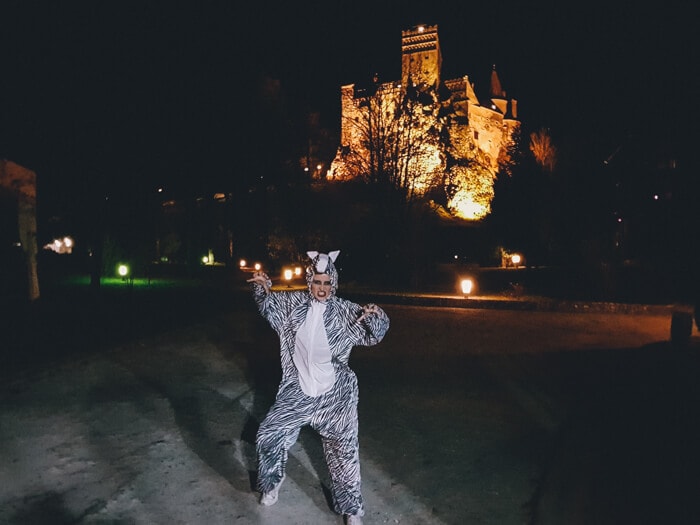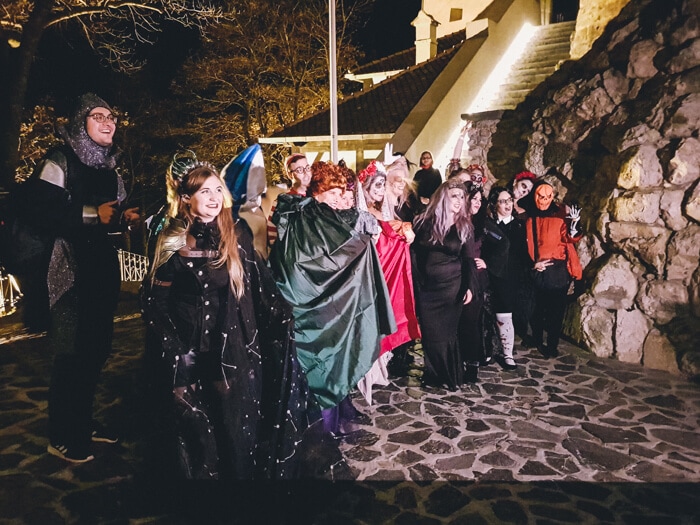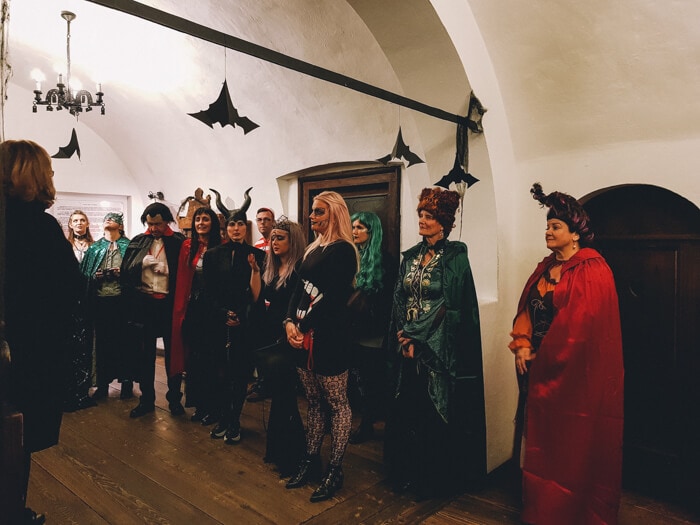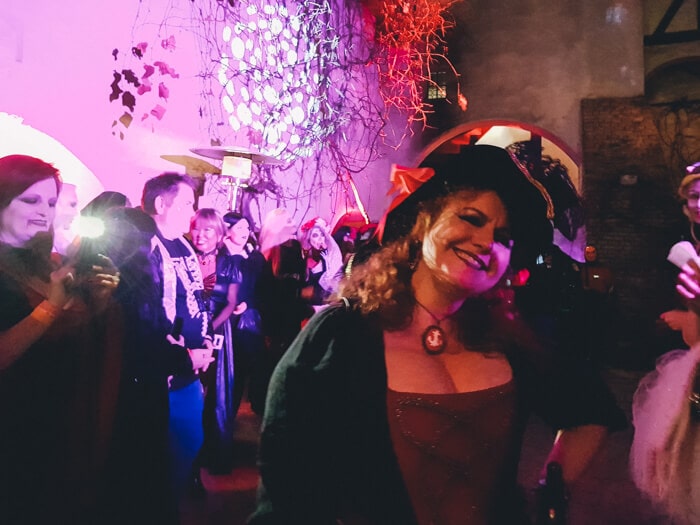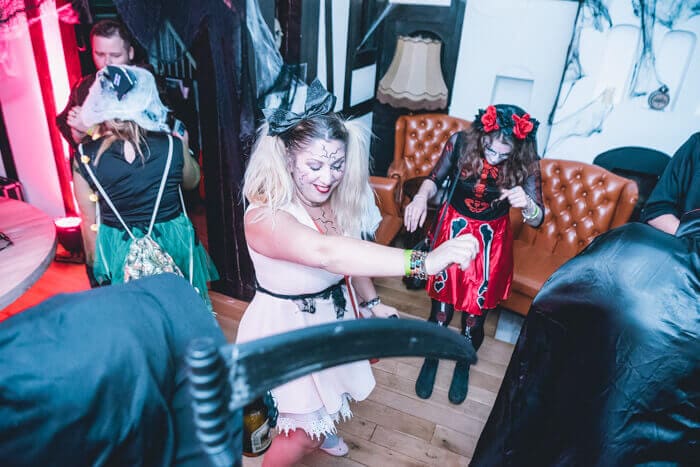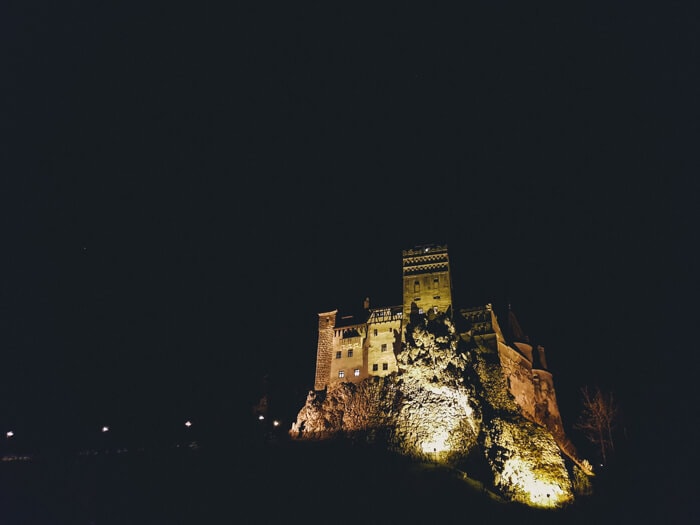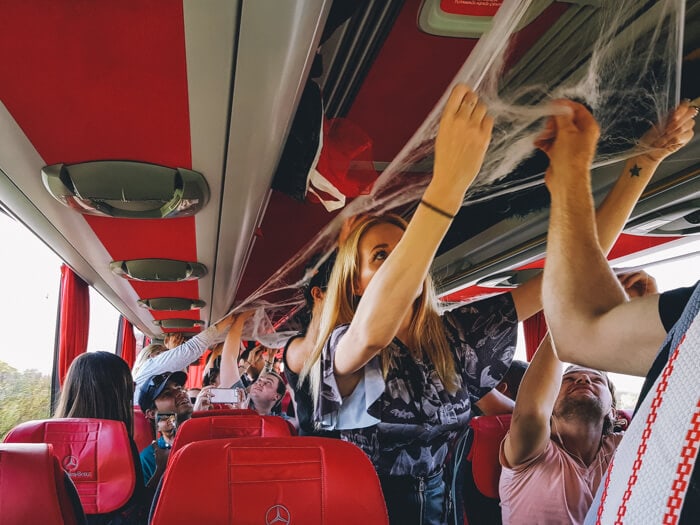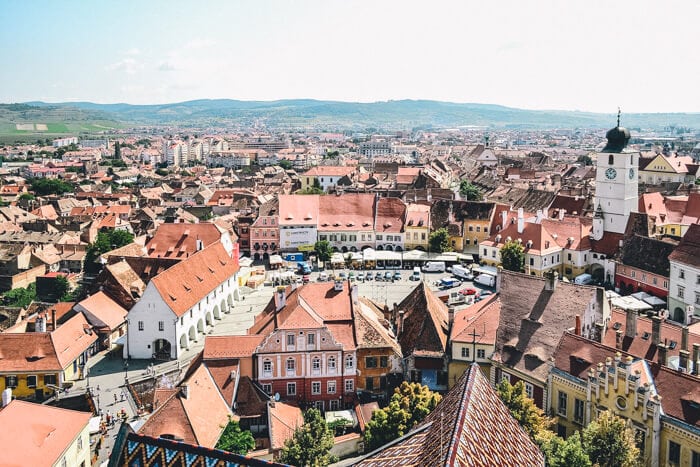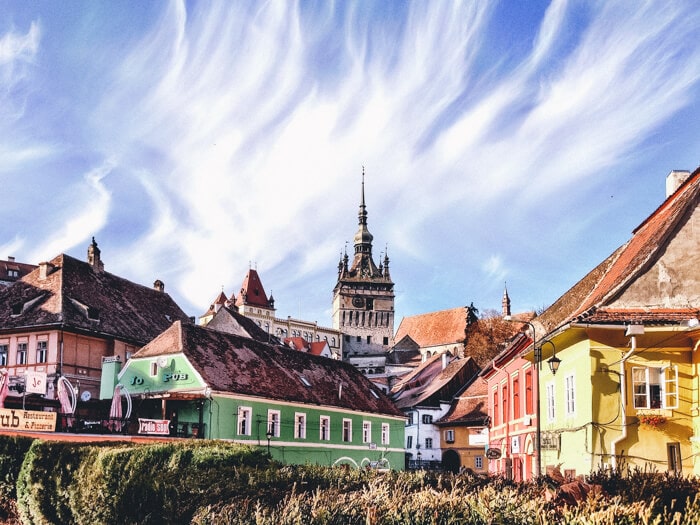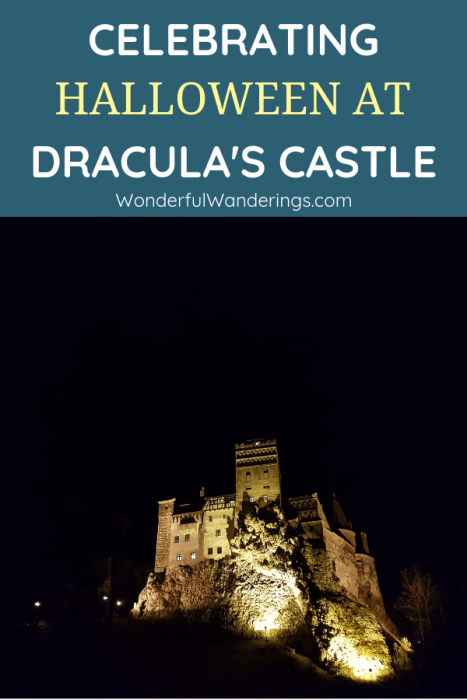Have you ever thought of celebrating Halloween in Romania, at the real Dracula castle? You can!
Last year at the beginning of October, an email landed in my inbox. If I wanted to join a G Adventures tour to celebrate Halloween in Transylvania, the birthplace of Vlad The Impaler, at the castle that became the home of Bram Stoker’s fictional character Dracula.
I’m not going to lie: I didn’t have to think twice about it. I’d been curious about G Adventures for years. Several people I know had already traveled with this award-winning responsible travel company and raved about their unique approach to things.
That curiosity was only spiked when I got a copy of “The Loop Tail”, founder Bruce Poon Tip’s book on the creation and constant evolution of this tour company, a few years ago.
On top of that, I’d never had the chance to visit Romania before, I’m a book geek, and growing up in Belgium, I’d never really celebrated Halloween as a kid. So how could I say no to dressing up for a Halloween party at a place that’s carved into literary history? Indeed, I couldn’t.
The 2019 G Adventures Tours to celebrate Halloween in Transylvania is already sold out but worry not: you can already save your spot for the 2020 tour. I recommend you book quickly if you want to do this to make sure you don’t miss out, as this year’s tour was sold out months in advance.
Contents
- Celebrating Halloween in Romania
- A bit of background on Halloween, Bran Castle and count Vladimir Tepes a.k.a. Dracula
- A Transylvania trip with G Adventures: what’s it like?
- The experience
- The itinerary
- Day 1: Bucharest
- 2. Day 2: From Bucharest to Transylvania
- 3. Day 3: From Sibiu to Sighișoara</h4 On day 3, it’s time to visit Dracula’s birthplace. Aside from having that “honor”, Sighișoara is also popular as a UNESCO World Heritage Site thanks to its well-preserved walled old town. You’ll be able to explore it on an orientation walk with your CEO, after which you’ll have plenty of free time to wander around on your own.
- 4. Day 4: From Sighișoara to Bran
- Day 5: Halloween in Bran!
- Day 6: Travel back to Bucharest
- Day 7: Time to say goodbye
- Optional activities
- Cost and other practicalities
- Pin for later
Celebrating Halloween in Romania
The Halloween party at Dracula’s castle is the highlight of a seven-day G Adventures tour celebrating Halloween in Transylvania. I’ll share more about the tour and the history of the castle further down in this post. Let me first tell you about the evening I became a vampire zebra.
The best Halloween party
Each year, G Adventures takes over Bran Castle on Halloween. The only way to get in and join the party is as a participant of their Transylvania tour… and making sure you’re dressed up. Loving comfort as much as I do, I opted for a zebra onesie.
I know, I know, not immediately the scariest thing around, but with a bit of makeup and vampire teeth, I can assure you I looked the part.
As soon as we arrived, it was clear that the costume bit was not to be messed with. I’ve seen some of the most amazing characters that evening, from vampires to witches, devils, cyborgs, snake people, and Cruella De Vil.
All of us were welcomed by the one and only Vlad The Impaler before starting our exclusive guided Dracula’s castle tour. I loved how every room was decorated with spider webs and other Halloween things as well as how our guide focused on sharing the darker parts of the castle’s history.
When our Bran Castle tour ended, we got to enjoy a delicious buffet for dinner. I honestly hadn’t expected much of this but it was so good I went back two times. Don’t judge. There were plenty of cold and warm veggies, meats, rice, and snack-sized bites. And yes, for those of you who know me, there was dessert too.
Once we’d all consumed enough energy to face a haunted night, the DJ’s turned up the music and the parties were on. I’m using the plural form because there were actually two dance floors at Bran Castle: one in the castle’s courtyard and one down at the teahouse.
Each had a bar and at each, there were surprise acts throughout the evening. Many people joined the costume competition at the castle and everyone went to see the fire artist just outside the castle wall. Also very cool were the breakdancers who tore up the teahouse patio. Figuratively speaking, of course.
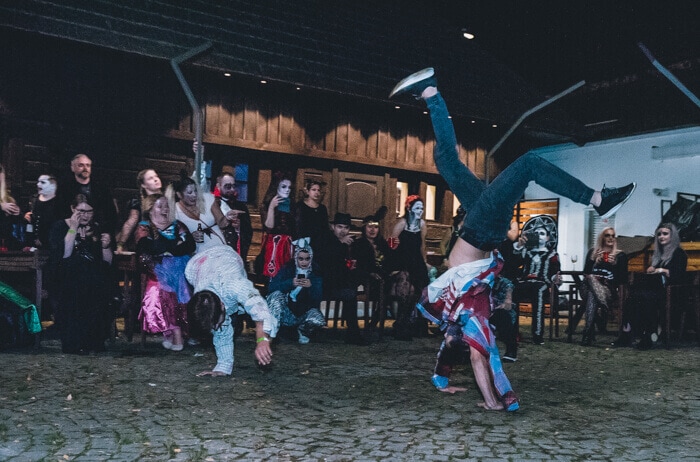
© FastenUrSeatbelts and G Adventures
With buses taking everyone back to their hotels throughout the night as well as first aid workers and security on site, you didn’t have to worry about anything. Well, except for Dracula lusting after your blood.
I moved between the castle and the teahouse to catch the different things going on and ended my evening somehow dancing to traditional Romanian music with a rabbit and a sorceress. At one point, there was also an alien that served as a limbo bar and a conversation with a man who’s teeth lit up like disco lights.
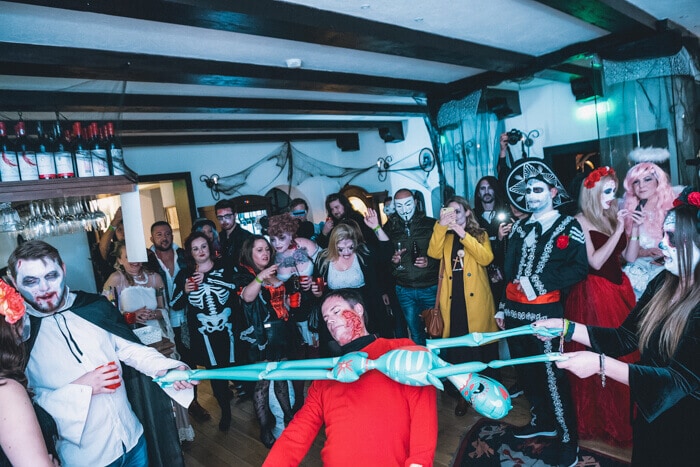
© FastenUrSeatbelts and G Adventures
The expression “to feel like a kid again” has become a bit of a cliché, but I can’t think of a better way to express how that party at Bran Castle made me feel. Normally not someone to dress up, I now found myself jokingly trying to bite people with my vampire teeth and carefully wandering around the castle as to not get startled by one of the scary creatures hidden in the corners and halls.
At the breakfast table in the morning, people were exchanging stories of the night before, the excitement bursting through the hoarseness in their voices. I sat silently with my cup of tea, wondering if that guy to the left of me had been that brave knight or the V from Vendetta man.
A bit of background on Halloween, Bran Castle and count Vladimir Tepes a.k.a. Dracula
What is Halloween?
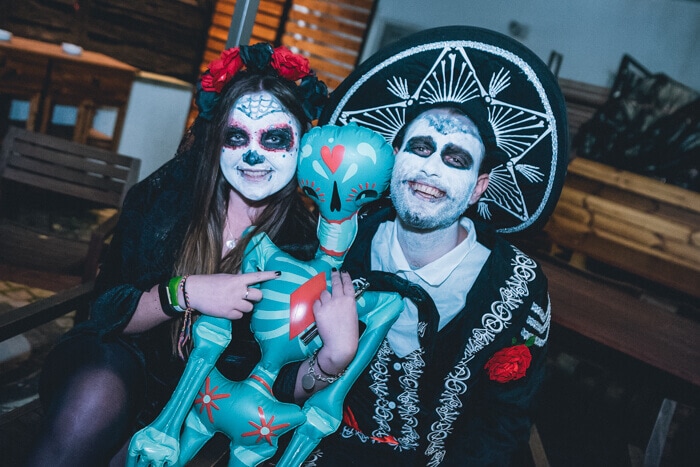
© FastenUrSeatbelts and G Adventures
Halloween is celebrated every year on the eve of October 31, the eve before All Saints also known as All Hallows Eve. But why is Halloween celebrated? Where does it come from?
While the link has never been fully proven, scholars assume that Halloween goes back to the Celtic festival of Samhain, a night on which people would light fires and wear costumes to scare away the ghosts. For the Celts, October 31 was the last day of the year and they believed that on this day, the border between the land of the living and that of the dead became blurred.
When the Romans conquered the Celtic territory, they very slowly started to mix in two of their own traditions with the festival of Samhain. “The first was Feralia, a day in late October when the Romans traditionally commemorated the passing of the dead. The second was a day to honor Pomona, the Roman goddess of fruit and trees.” (Source: History.com)
With the rise of Christianity, came the celebration of All Martyrs day, which was first celebrated in May but then moved to November 1 and changed to include all saints as well. Later, All Souls day was added on November 2 and the festivities – very similar to those of Samhain, with bonfires and dressing up – were stretched to include the night of October 31. It’s not unlikely that the Church was trying to replace the Celtic tradition with its own.
Today, a lot of us in Europe see Halloween as a marketing event that’s flown over from the US but in reality, it’s a celebration that was taken there by British and Irish immigrants. And it was there that it evolved into a secular, more community-focused holiday.
Even the popular Halloween activity of trick-or-treating may have its roots in Celtic traditions, as on the night of Samhain, Celts would dress up to go knock on doors asking for food. A similar thing took place in medieval England when poor people would go around asking for “soul cakes”, something to eat in return for prayers for the giver’s soul.
It’s not known if both practices were related but both seem to have influenced the Halloween we still celebrate today.
Some Dracula facts
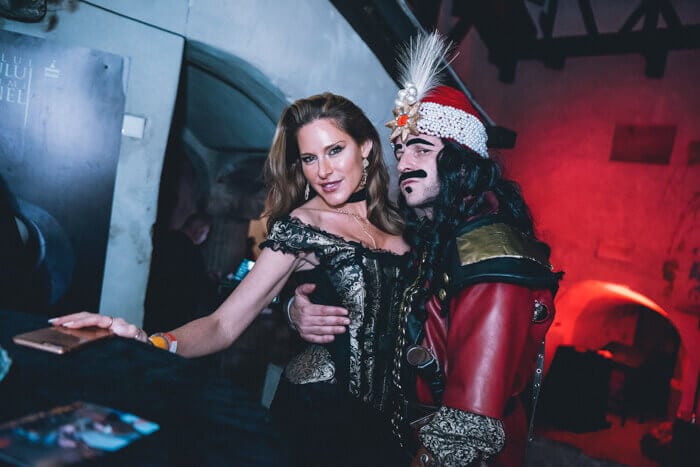
© FastenUrSeatbelts and G Adventures
Alright, but what has Dracula go to do with Halloween? Not much, really, except that he’s a scary character known all over the world and thus the perfect companion to celebrate this dark holiday with.
Who is Dracula exactly?
Bram Stoker’s Dracula is a fictional character presumably based on the historical figure of Count Vlad Dracula, also known as Vlad III or Vlad Tepes, a nickname translated as “Vlad The Impaler”. Known now mostly as the inspiration source for the world’s most famous vampire because of his cruelty – he would literally impale his enemies – Count Dracula is to this day seen by many Romanians as a hero who fought for Christianity and against corruption.
As a young boy, he and one of his brothers were held captive and raised by the Ottomans to secure their father’s loyalty to the Ottoman Empire. Over the course of his upbringing, several events nurtured his hate against the Ottoman Empire as well as noble Wallachian families who were said to have had a hand in the death of his father and an older brother. They strengthened his will to take back the land his family had ruled and become prince of Wallachia, a geographical region now part of Romania, so he could get revenge.
The name “Dracula” means “son of Dracul” or “son of the Dragon” and goes back to the fact that his father, Vlad Dracul II, was a member of the Christian order of the Dragon, meant to defend Christian Europe against the Ottomans.
Some Bran Castle facts
While it is widely assumed that the vampire castle in Bram Stoker’s Dracula book is based on Bran Castle, it’s highly unlikely that the real Vladimir The Impaler ever lived there,. He did not own the castle and when he lived, it was used as a military fortress, not a home for a nobleman.
It is, however, possible that he passed there on several occasions while traveling through his lands and it’s also assumed, though not proven, that he was a prisoner at Bran Castle for two months when he was defeated by the Hungarians.
Did you know, by the way, that Bram Stoker never even visited Romania? He is believed to have based his Dracula story entirely on research, tales told to him by others and Romanian folklore. His Bran Castle description is based on nothing more than the descriptions of others.
Some things that are true about Bran Castle:
- The earlier records of a castle on the site of Bran Castle go back to 1212.
- It was long used as a military fortress as well as a safe passage between Wallachia and Transylvania.
- After the Treaty of Trianon in 1920, it became a royal residence of the Kingdom of Romania.
- It was taken by the Communists in 1948 and only returned to the royal family in 2006.
- Renovated, it opening to the public in 2009 as a private museum.
A Transylvania trip with G Adventures: what’s it like?
The experience
As this was my first time traveling with G Adventures, I want to share a bit about that in particular before giving you the full itinerary of their Transylvania and Dracula tour.
When you travel with G Adventures, you get appointed a CEO or Chief Experience Officer. This is the person who will take care of you for the duration of the trip. He or she has the itinerary, shares information about the places you go to and the things you see, makes sure you get everywhere on time and is there to answer any questions you may have.
Our CEO Stefano was a bundle of energy who did all he could to keep us entertained throughout the trip. On the bus, he organized a quiz, shared fun facts and had everyone work together to decorate it with spider webs.
When we had free time, he offered suggestions on what we could do and when there was an orientation walk, he left us the freedom to decide whether we wanted to participate or further explore on our own. He also had some great tips for lunch and dinner spots.
The program was put together in such a way that we got to do a bunch of things but never felt rushed. This also helped me to connect with my fellow travelers which wasn’t that hard since we were all there for the same thing: Halloween!
The itinerary
Day 1: Bucharest
The 7-day tour departs from and returns to Bucharest. Everyone’s free to travel to the Romanian capital as they choose as long as you arrive in time for the evening welcome meeting. This is when you’ll meet your CEO (Chief Experience Officer) who will share details about the course of the tour.
2. Day 2: From Bucharest to Transylvania
On the second day, you’ll drive to the town of Sibiu. It’s the longest distance you’ll cover on this trip, but you’ll make stops along the way.
The first stop isn’t directly related to Dracula but would be a shame to miss. The Curtea De Arges Monastery is a beautiful Byzantine-style Romanian Orthodox cathedral with rich decorations and many legends woven into its history.
Next up is the Poenari Castle. It used to be one of the main strongholds of Vlad The Impaler and lies no less than 1,400 steps up a mountaintop. Contrary to Bran Castle, Prince Vlad actually spent time here.
Part of the fortress lies in ruins now but two of the towers and its walls still stand strong.
Once you’ve arrived in Sibiu, you have the option to join an orientation walk with your CEO or visit some of the city’s sites independently, such as the famous Brukenthal Museum.
3. Day 3: From Sibiu to Sighișoara</h4

On day 3, it’s time to visit Dracula’s birthplace. Aside from having that “honor”, Sighișoara is also popular as a UNESCO World Heritage Site thanks to its well-preserved walled old town. You’ll be able to explore it on an orientation walk with your CEO, after which you’ll have plenty of free time to wander around on your own.
Top G Adventures tip: grab a bite at the Casa Dracula. Yup, Vlad’s birthplace is now a restaurant serving regional cuisine.
4. Day 4: From Sighișoara to Bran
Can you feel the suspense rising? On day 4, you’ll drive from Sighișoara to Bran, home of the castle that inspired Bram Stoker and the place where you’ll celebrate Halloween.
But not just yet. You’ll first make a stop at the 14th-century Rupea Citadel before you have some free time to explore Bran.
Day 5: Halloween in Bran!
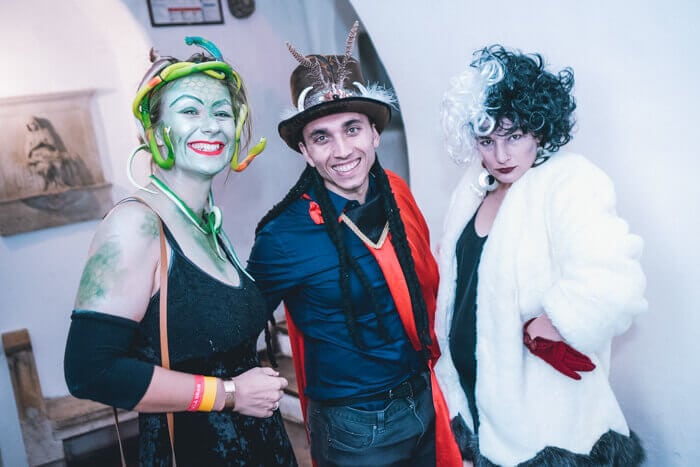
© FastenUrSeatbelts and G Adventures
Today’s the day! You’re free all day to get ready for a killer (see what I did there) Halloween party at Bran Castle in the evening. Put on your costume, go crazy with the scary makeup and join an exclusive guided tour and buffet dinner at the castle before the DJ turns the music up.
Day 6: Travel back to Bucharest
On the last full day of the tour, you’ll visit the Snagov Monastery where Dracula’s remains are supposedly buried. Afterward, you’ll continue on to Bucharest’s city center to roam around as you please. This is a great opportunity to see the city at your own pace.
Day 7: Time to say goodbye
The last day of the tour is the departure day. You’re free to leave as you please or stick around a little longer if you like. After having spent such a fantastic week with fellow Halloween lovers, it’s totally understandable if you don’t want to go home just yet.
Optional activities
You’ll have noticed that the program above leaves quite a bit of time for free exploration. At these moments, you are truly free to wander around on your own. No need to plan much, though, as G Adventures always gives some recommendations for things to do.
Cost and other practicalities
I could give you a full breakdown of the cost of this trip, the kind of accommodation you’ll stay at, the people you’ll be traveling with and more, but it would be a bit silly to do so as everything is explained in detail on the G Adventures website.
For all the information you need as well as to book this wicked tour, click here.
Good to know:This tour sells out fast. The 2019 tour is already sold out but you can already sign up for the 2020 one!
If you were wondering about what to do on Halloween, I hope this post provides a clear answer :-)
Pin for later
G Adventures invited me to join part of their 7-day Transylvania tour so that I could share my experience with you. Whenever I enter partnerships like this, you can be assured that I only share my own opinion on here.
Find below our top guides about Romania.

